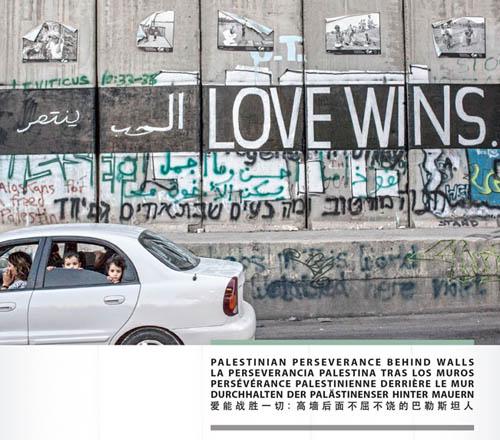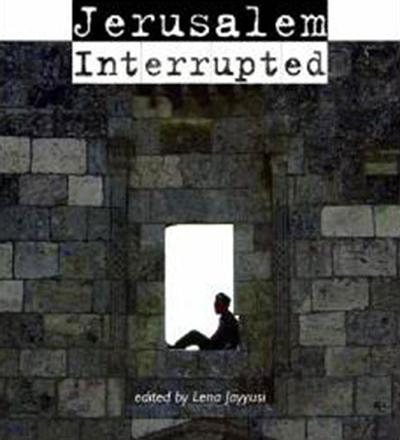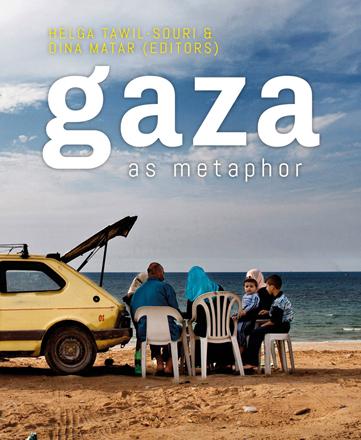Keep Your Eye on the Wall: Palestinian Landscapes
Edited by Olivia Snaije and Mitchell Albert
London: Saqi Boos, 2013
Due to its format, this collection of photos and essays about Israel’s apartheid wall is more than a book. It is an imaginative project shaped in the form of an accordion. Several pages can be folded out at once to give panoramic views that reveal the immensity of the wall, and how it virtually looms over Palestinian spaces. Reaching the end of the book, one realises it is only the end of the first half; one must flip the pages in the other direction to view the rest of the text and photos. There are no page numbers, and one can in principle begin at either end. This can be a bit disorienting but much less so than the experience of Palestinians who have had this monstrosity erected in their neighborhood. It is as though those who conceptualised the project wanted to counterpoise an elegant, expressive, open-ended construct to the ugly, oppressive, closed construct that is the wall. “Keep Your Eye on the Wall” was first published in France, and credit for the brilliant graphic design goes to Agnes Studios in Paris.
The contributors, mainly Palestinian, along with an Israeli and a few internationals, are all well versed in the Palestinian issue, the wall and its implications. Their sharp perceptions, whether reflected in text or pictures, open a range of possibilities in contrast to the wall itself, which is shown to be a dead-end undertaking, no matter how much negative influence it exerts in the here-and-now. To make this point, the text begins with the following comparison: “Symbolically, the wall in Palestine is this century’s Berlin Wall, albeit four times as long as that hated Cold War icon and more than twice as high.”
In the foreword, Raja Shehadeh compliments the photographers that contributed to this volume — Noel Jabbour, Raed Bawayah, Kai Wiedenhofer, Taysir Batniji, Raeda Saadeh, Steve Sabella and Rula Halawani, for their photographs which are “shockingly beautiful and evocative — by far the best I have seen of the separation barrier”.
Christine Leuenberger writes about the wall in the context of the network of barriers, checkpoints and separate road systems that partition the West Bank and restrict movement between Israeli- and Palestinian-controlled areas, greatly limiting the number of places where Palestinians and Israelis encounter one another. “Spaces in which to discuss peace have become increasingly difficult to come by…“ She also places the Wall in an international context as such barriers are being built in many other places, dividing peoples and cultures.
In a thought-provoking essay, Malu Halasa tackles the difficult question of whether doing art work on the wall serves to beautify it or to express resistance. In the process, she addresses shifts in the focus of Palestinian art over the years.
Yael Lerer is one of a small group of Israelis who have continued to visit the Palestinian territories even after 2000 when their entry was forbidden in line with the Israeli government’s separation policies. He even finds the silver lining in the cloud: Barred from using the main roads as in the past, “we were introduced to the beauty of rural Palestine — step by step, journey by journey,” when going “to visit friends, participate in demonstration, buy books or attend theater performances.” And he has some tales to tell.
In her intense prose style, Adania Shibli contributes a short story that allegorically conveys the psychological impact of the wall being erected in the private and communal space of those Palestinians who were so unlucky as to live in its path.
“Keep Your Eye on the Wall” proves the old adage that a picture is worth a thousand words, and one must actually see the book to get the full effect. Still, one can’t resist describing some of the photos that constitute the heart and soul of “Keep Your Eye on the Wall.” Besides those depicting the sheer expanse of the wall, there are many that juxtapose it with ordinary figures, producing eerie contrasts: A horse grazes peacefully alongside it; children eat a snack, or a man trudges home, in its shadow. A series of stark, black-and-white photos reveals the life of those who must scale it and live in the rough to earn a living. In other pictures, graffiti and paintings cover its grey drabness, while still other photos suggest new visions of resistance to its seeming permanence.
This is only a preview of what is in store for the reader/viewer in a project meant to shake up perceptions, even to shock. Hopefully, it will shock more people around the world into joining the movement against the Wall and the occupation that gave birth to it.


















